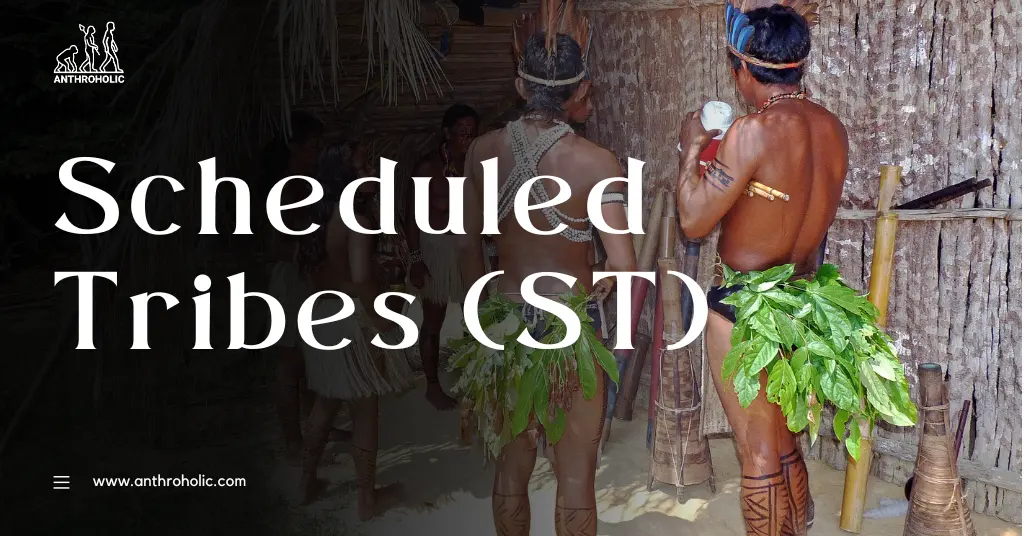AI Answer Evaluation Platform Live Now. Try Free Answer Evaluation Now
Scheduled Tribes
The concept of Scheduled Tribes (ST) in India represents an essential facet of the nation’s social fabric. Classified under the Constitution, Scheduled Tribes are communities with unique cultural identities, traditions, and geographical isolation [1].

Definition and Classification
Constitutional Recognition
The term “Scheduled Tribes” refers to the indigenous communities that are acknowledged under Article 342 of the Indian Constitution. The President of India, after consultation with the respective state government, can declare a community as a Scheduled Tribe [2].
Criteria for Identification
The criteria for identifying Scheduled Tribes encompass four major factors:
- Indications of primitive traits
- Distinctive culture
- Geographical isolation
- A lack of social and economic advancement [3]
| Criteria | Description |
|---|---|
| Primitive Traits | The presence of primitive traits that distinguish them from the mainstream population. |
| Distinctive Culture | Unique language, rituals, and customs. |
| Geographical Isolation | Living in remote and inaccessible areas. |
| Economic & Social Backwardness | A lack of access to modern facilities and social marginalization. |
Legal Provisions and Protections
- Constitutional Protections: The Constitution of India provides several protections to Scheduled Tribes under various articles, such as Article 15(4), Article 46, and Article 335, among others [4]. These protections aim to ensure social justice, economic development, and educational advancement.
- Legislative Measures: Several legislative measures are in place to protect the rights and interests of the Scheduled Tribes, including the Scheduled Castes and Scheduled Tribes (Prevention of Atrocities) Act, 1989, and the Forest Rights Act, 2006 [5].
Challenges Faced by Scheduled Tribes
- Social Challenges: Social challenges include discrimination, stigmatization, and exclusion from mainstream society. These factors often lead to a lack of access to education, healthcare, and employment opportunities [6].
- Economic Challenges: Economic challenges encompass poverty, land alienation, and limited access to credit facilities, severely impacting the livelihoods and overall well-being of the Scheduled Tribes.
- Cultural Challenges: Cultural challenges involve the erosion of traditional practices and customs, often due to urbanization and globalization, leading to a loss of cultural identity.
Socio-Economic Development
- Education: The literacy rate among Scheduled Tribes is significantly lower than the national average. Efforts have been made to improve education through schemes like Eklavya Model Residential Schools (EMRS) and Post-Matric Scholarships for tribal students.
- Healthcare: Healthcare facilities are often lacking in tribal areas. Programs like the Janani Suraksha Yojana (JSY) aim to provide better healthcare support, especially for maternal and child health.
- Employment: Employment opportunities remain scarce, with many tribal people relying on traditional occupations. The Mahatma Gandhi National Rural Employment Guarantee Act (MGNREGA) has been instrumental in providing employment in tribal areas.
Cultural Preservation
Recognition of Culture
The Government of India acknowledges the distinct cultural heritage of Scheduled Tribes and has established institutions like the Tribal Cultural Research and Training Institutes to preserve and promote their cultural practices.
Impact of Globalization
The encroachment of modernity and globalization has threatened the cultural integrity of Scheduled Tribes. Strategies must be developed to protect and sustain their unique cultural identities.
Political Representation
Scheduled Tribes are granted political representation under Article 330 and 332 of the Constitution, ensuring reserved seats in Parliament and State Legislative Assemblies. However, the realization of political empowerment remains a challenge.
Environmental Consideration
Relationship with Forests
Scheduled Tribes often inhabit forest regions and share a symbiotic relationship with the environment. The Forest Rights Act, 2006, recognizes their rights to inhabit and use forest land.
Challenges and Conflicts
Conflicts often arise between development projects and the conservation of tribal habitats. Balancing ecological considerations with tribal rights remains a complex issue.
Future Prospects
Policy Implementation
The effective implementation of existing policies and laws remains pivotal to enhancing the socio-economic status of Scheduled Tribes.
Community Participation
Encouraging participation from the tribal community in decision-making processes is essential for policies to be more relevant and effective.
Conclusion
The Scheduled Tribes of India stand as a testament to the country’s diverse cultural landscape. Their recognition, protection, and development involve a complex interplay of historical, legal, social, economic, and cultural factors. Coordinated efforts from various stakeholders, coupled with sensitivity to the unique characteristics of these communities, can pave the way for their inclusive growth and empowerment.
References
[1] Ministry of Tribal Affairs, Government of India. “Scheduled Tribes in India: Definition and Criteria.”
[2] Constitution of India, Article 342.
[3] Xaxa, V. (1999). “Transformation of Tribes in India: Terms of Discourse.”
[4] Constitution of India, Various Articles.
[5] Ministry of Tribal Affairs, Government of India. “Legal Framework.”
[6] Thorat, S., & Neuman, K. S. (2012). “Blocked by Caste: Economic Discrimination in Modern India.”




